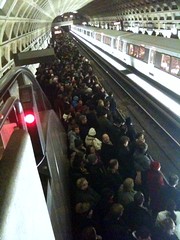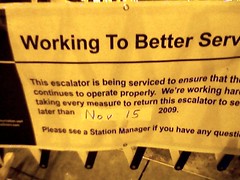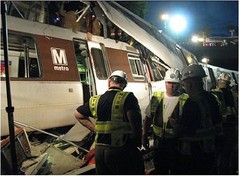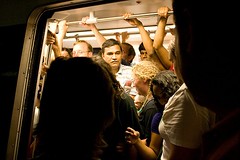The crumbling of the DC Metro

Posted July 22, 2010 at 1:27PM
The many workers and administrators who make our public transportation systems work as well as they do for so much of the time deserve our praise and support. Held back by tight and shrinking budgets, frequently placed in poor and dangerous working conditions, and forced by the nature of their business to work with aged and faulty systems at the same time that those systems are heavily used, these good people are asked to do the impossible and to take the heat when expectations are not met. This certainly goes for the nation’s second-busiest system, in Washington, DC where I live.
But, notwthstanding their efforts, I find myself using DC’s Metro less and less these days, in no small part because it just doesn’t work as consistently well as I need it to in order to meet my needs. Although our Metrorail system has never been perfect, it has always been a marvel of architectural beauty and engineering achievement, and once was the envy of the nation for its cleanliness, comfort and efficiency.
 Sadly, that is no longer the case. Today, access to the system is made difficult by broken escalators and elevators all over the system; service can be slow and unpredictable; cars are dirty and crowded; air conditioning systems sometimes provide mediocre cooling in DC's sweltering summer heat.
Sadly, that is no longer the case. Today, access to the system is made difficult by broken escalators and elevators all over the system; service can be slow and unpredictable; cars are dirty and crowded; air conditioning systems sometimes provide mediocre cooling in DC's sweltering summer heat.
I used to take Metro all the time for commuting and frequently for other trips as well. But, while I still use the system several times per week, frequently to shuttle around downtown for meetings, more often than not I now drive to work, shelling out $20 for parking each day and putting up with traffic hassles when I do. Part of this, I’m sure, is not just Metro’s age but my own. Now in my (low!) 60s, I am less tolerant of hassles than I was in, say, my 20s and 30s when I didn’t particularly care if I got a seat or not or whether there was decently working a/c. These things matter more than they used to. If I am going to walk the half-mile to the station in the heat and humidity, I want comfort, efficiency and reliability when I get there. Unfortunately, those are the things that Metro riders can no longer count on.
Perhaps the most aggravating problem is the constant disrepair of the system’s many escalators, some among the longest in the world, necessary to access or exit the platforms. The subject of an article in yesterday’s Washington Post, this is a problem that has plagued Metro from the very beginning but seems to be getting worse as the system ages and ridership has increased.  Metro officials say that, at any given time, about 10 percent of the system’s escalators are not working, but it sure seems like more than that on my routes. Maybe the problem is worse in the stations in the central city, more heavily used than those in the suburbs? (A recent major escalator failure in the inner suburb of Bethesda might suggest otherwise, though, as do breakdowns in other suburban stations.) I can guarantee that the two escalators at the 12th & G Streets entrance to the Metro Center station – which happen to be the closest to NRDC’s office – have both been working at the same time less than half the total time since we first moved into the neighborhood fourteen years ago.
Metro officials say that, at any given time, about 10 percent of the system’s escalators are not working, but it sure seems like more than that on my routes. Maybe the problem is worse in the stations in the central city, more heavily used than those in the suburbs? (A recent major escalator failure in the inner suburb of Bethesda might suggest otherwise, though, as do breakdowns in other suburban stations.) I can guarantee that the two escalators at the 12th & G Streets entrance to the Metro Center station – which happen to be the closest to NRDC’s office – have both been working at the same time less than half the total time since we first moved into the neighborhood fourteen years ago.
Outages caused near-riots recently at the Dupont Circle station, whose escalators are among the system’s longest and steepest but failed at rush hour. My recently departed (and already missed) colleague Gaby Chaverria happened to be escorting her mother around town at the time, in near-100-degree heat, and managed to be caught in the resulting mess in both Dupont and Bethesda. Gaby is a loyal city dweller who doesn’t own a car, basically trying to show her somewhat elderly mom what’s great about her city. She was extremely discomfited and frustrated by the experience.
Here is an 16-second video of passengers struggling to walk up a broken Metro escalator at Dupont Circle:
(The video is by Twitter user @giveit2lloyd and you can view the original here.)
I get the impression that Metro and its contractors are more or less always working on the escalator issues, but the truth seems to be that their limited budget means that new breakdowns are occurring faster than repairs of old ones. It is hard to feel confident that this problem is going away, since budgets aren’t going up and the system will only get older. The elevators, which provide a poor alternative to the escalators in terms of capacity but are essential for disabled passengers, are constantly breaking down as well. Every Metro passenger is familiar with the drone of announcements in Metro stations identifying elevator outages, which seem to go on and on.
The nadir of Metro’s problems has to have been the July 2009 crash of two trains that killed nine people. That is genuine tragedy, not just inconvenience, and one’s heart goes out to the victims’ loved ones.  That crash (like other transit systems, Metro has suffered other fatalities over the years, but that was the worst single incident) prompted all sorts of investigations. One result, unfortunately, is that service immediately got worse, as trains were slowed as a precaution and operators switched to manual braking rather than automatic. This particularly plagued the Red Line, the system’s busiest and the one I use for commuting. I don’t think service on the Red Line has yet fully recovered, over a year later. Perhaps more alarmingly, the system’s safety record has gotten worse, not better, since the accident, a federal safety official citing ‘significant deficiencies in [Metro’s] safety culture.’
That crash (like other transit systems, Metro has suffered other fatalities over the years, but that was the worst single incident) prompted all sorts of investigations. One result, unfortunately, is that service immediately got worse, as trains were slowed as a precaution and operators switched to manual braking rather than automatic. This particularly plagued the Red Line, the system’s busiest and the one I use for commuting. I don’t think service on the Red Line has yet fully recovered, over a year later. Perhaps more alarmingly, the system’s safety record has gotten worse, not better, since the accident, a federal safety official citing ‘significant deficiencies in [Metro’s] safety culture.’
Slower service is one of many factors leading to overcrowding, as the system now operates with ridership exceeding designed capacity much of the time. That problem is only going to get worse if you prefer to sit down as you ride, since one of the ways Metro is dealing with it is to put new cars on the system that have more standing-room capacity but fewer seats. Budget shortfalls have also led to frequency and capacity of service being either stagnant or reduced (fewer cars and longer waits at some hours on some routes), when service really should be increasing to meet demand and to help reduce environmental problems caused by driving.
For some reason, Metro also seems to be plagued with door-closure problems, which cause further delay because an incident with any one door prevents the train from moving until resolved. Usually this is the fault of a stray passenger who, because of crowding, has unknowingly gotten a strap or something caught in the doorway.  This problem seems actually to have gotten a little better over the years, since the days of the ubiquitous recorded ‘PLEASE stand clear of the doors!’ messages, supplemented occasionally by an operator announcement that ‘if you do not move clear of the doors, I am going to have to offload this train’ warnings. But it still occurs, and I wonder why, when I never encounter the issue in other rail transit systems around the world. And, although the immediate cause is usually an errant passenger, the underlying cause is overcrowding that forces passengers to stand pressed against the doorways.
This problem seems actually to have gotten a little better over the years, since the days of the ubiquitous recorded ‘PLEASE stand clear of the doors!’ messages, supplemented occasionally by an operator announcement that ‘if you do not move clear of the doors, I am going to have to offload this train’ warnings. But it still occurs, and I wonder why, when I never encounter the issue in other rail transit systems around the world. And, although the immediate cause is usually an errant passenger, the underlying cause is overcrowding that forces passengers to stand pressed against the doorways.
As I have written before, one of the major shortcomings of the federal stimulus legislation is that it provided almost no assistance for transit operating expenses, the transportation area of greatest need and where jobs were (and are) being lost or endangered because of cutbacks. There was nothing ‘shovel-ready,’ unfortunately, about operation of infrastructure that already exists. That needs to be fixed in the next federal transportation bill.
I have lived in DC long enough to remember a time before Metro. Although bus service was arguably a little better then than it is now (more routes, more direct service since now many bus routes feed into Metro stations where passengers must transfer), Metrorail has undeniably been a wonderfully transformative accomplishment for our city and region. It has, without a doubt, made the city work better in many ways, and spurred some very good urban development. It is a huge part of why the city feels more vibrant and cosmopolitan than it once did. But, if service has deteriorated to the point where Metro can no longer claim me, a professional advocate for public transit, as a loyal customer, it has a problem.
Move your cursor over the images for credit information.